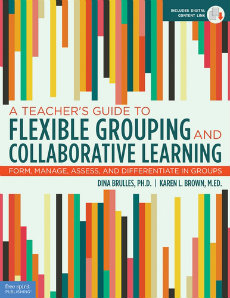Flexible Grouping and Collaborative Learning
A Teacher’s Guide to Flexible Grouping and Collaborative Learning: Form, Manage, Assess, and Differentiate in Groups
By Dina Brulles, PhD, and Karen L. Brown, MEd
(Free Spirit Publishing, 2018 – Learn more)

The classroom environment is ultimately what is important to the success of student learning. Grouping students involves observation, data collection, and analysis, as well as creating groups that offer flexibility within mixed-ability classrooms.
A Teacher’s Guide To Flexible Grouping and Collaborative Learning is a resource that will help teachers design, assign, engage, and support as they create optimal learning groups for a variety of purposes.

Visuals such as the “Chart of Common Grouping Patterns” are useful in defining and clarifying the various types of grouping within and even outside of the classroom.
The book is broken into two parts. Part 1 explains ways to structure, manage, and set routines with small groups. Part 2 offers instructional strategies to use with flexible learning groups.
The authors suggest working through the book from the beginning to the end. The rationale provided is that in doing so the reader will gain an understanding of how to form the learning groups and this may increase the effectiveness of the strategies presented later in the book.
Behavior challenges with using groups
As a teacher, I find that grouping can often lead to behavioral issues. The authors state in the beginning of the book that behavior management is an underlying strength in their book. It is my belief – and I found support for this belief while reading this book – that behavioral management is a key element in successful grouping.
In Chapter 2, “Establishing Structure in Classrooms That Group,” resources are provided to help maintain an engaging learning environment. Many times the one element that can disrupt the learning is the management of what students are to do when they are not meeting with the teacher.
The authors’ advice addresses the way groups transition from activities, voice level, off task conversations, and how needed tools and supplies are distributed. This is summarized in two charts, “Tips for Managing Student Movement Between Groups” and “Tips for Establishing Acceptable Noise Levels.” Classroom scenarios are also provided, helping to highlight what this may look like, as well as recommending procedures to help implement the routines.
Managing assessment
Assessment is an area that can get a bit tricky when it comes to working with group learning. Chapter 3 offers suggestions for assessing data and using assessments to gauge success. Within this chapter are “Seven Processes for Using Assessment,” and each is explained in detail. On page 59, Figure 3.3 “Recordkeeping Format Idea” charts the group format, description, and facilitator.
The process of grading is also discussed and resonated with me as the authors stated, “Many grading systems use an average or weighted average to determine student grades. When using this type of system, be careful that students are not punished for learning material less quickly than others or for losing interest in tasks because they already know the material.” (page 60).
Process six detailed communicating goals, expectations, and feedback. Feedback is to be evidence based and link specifically to the learning outcome. Finally, sharing with parents is an important element, and strategies are provided such as having checkpoints and conferences with groups.
Keeping notes of group progress, as well as individual progress within the group, helps to maintain a positive learning environment as well as offer specific communication to parents. As a teacher who groups, I found the information in this chapter to be highly valuable and applicable to my classroom.
Adding questioning to the mix
Chapter 5 offers “Strategies for Extending the Learning Processes in Groups.” Within this chapter, the authors offer nine types of questioning and their use for the different levels of learning groups. Included is a chart showing the different types of questioning, a brief description, and examples. In addition, thinking expert Edward de Bono’s “Six Thinking Hats” questioning technique is offered. The various colored hats “challenge the individual to view the information through a different lens.” The text defines questioning by lens and provides examples of each.
Print and digital resources
The authors provide resources throughout the book. Part 1 offers “Possible Goal Expectations List,” a “Goal Setting: One Day/Week at a Time” chart, a checklist of sorts titled “Is Your Classroom Ready to Group?” and a “Log of Extension Activities.” Part 2 offers a “DOK Extension Lesson Template,” an “Essential Project Design Elements Checklist,” a “Tiered Lesson Planning Chart,” and the “Extension Menu Planning Form.”
Digital content is provided via CD with customizable versions of all reproducible forms, a PDF presentation for use in professional development along with downloading directions. In addition, a free downloadable PLC/Book Study Guide is available.
Kathleen Palmieri is a fifth grade teacher in upstate New York. With a passion for literacy and learning in the classroom, she participates in various writing workshops and curriculum writing endeavors. As a lifelong learner, she is an avid reader and researcher of educational practices and techniques. Kathleen blogs about books at her blog Books We Love Sharing. Collaborating with colleagues, and globally on Twitter @ Kathie042500, is an ongoing practice for her.




































